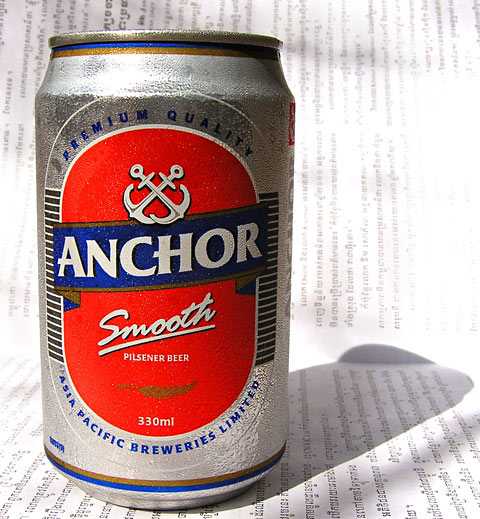It says something very special about the Cambodian national psyche that the nation’s two most popular beers share the same name. APB, the now-owners of this pan-Asian trash beer, somehow convinced Cambodia to pronounce their pilsener “Anne Chore” instead of “Angkor”. In a more just and reasonable world, the correct pronunciation would be “aing churr” which approximates the words “barbecued sick” in grammatically nonsensical Khmer.
APB says: “Anchor was first brewed in Singapore over 70 years ago using German technology and brew masters. Anchor’s value-for-money positioning and its refreshing and signature crisp taste have clearly struck a chord with drinkers in over 10 countries in Asia.”
I say: With a little more fine-tuning of their German technology, APB could release the first beer that is both colour and flavour of a crisp mountain stream. Initial aroma of rotting straw counts as a redeeming quality because it confirms that I haven’t accidentally poured myself a glass of aluminium-flavoured soda water. Like a b-grade slasher film, there was no head or body, just the inescapable sweet aftertaste of corn syrup faux-blood.
Availability: Absolute ubiquity in Cambodia. In cans and draught.
See also: Angkor Lager

Hey Phil, the photography on your blog is improving all the time, and I’m quite impressed by the contrast of the condensation droplets on the beer can. You do have some issues with barrel distortion though; I suggest using a lens with a longer focal length.
I use a cheapish point and shoot camera, so lens choice isn’t much of an option for me. I’ll certainly be upgrading to a proper SLR when I get back on First World wages. In the mean time, I could probably correct the barrel distortion in Photoshop though.
I just discovered the Distort > Lens Correction filter. I’m naming my first-born “Adobe”
Check out Chug’d, the new social network for beer lovers!
Distortion might have been induced by taking photos atop the Khmer section of the Daily. Try photographing atop Rasmei Kampuchea for the classic “gun barrel” distortion. Or take the classic photographer’s way out and take photos of things without straight lines (waterfalls, plates of bok lahong, nekkid ladies, etc)
Over the years, an embarrassing number of hot Anchors have curled my tongue, and taste will out. Hence, I’ve come to the conclusion that APB’s blurb is technically accurate. I am curious, though, where they find all the sweaty, porcine German brewmasters they stuff in the mash tun.
Filthy, nasty, stuff.
Give me Beer Lao anyday.
Went to a provincial wedding a couple of weeks ago, they served Love Beer – agggghhhh
Lord Playboy
http://www.khmer440.com
I must admit that I have a weird affection for Anchor that I managed to completely underplay when trying to review it. It’s a bad beer but it doesn’t stop me from preferring it over most of the other bad beers, for no apparent or justifiable reason.
Jerry – Now you know where to look every time a German tourist goes missing in South East Asia.
PB – Surely Love Beer merits sending a proxy to the wedding with your envelope full of cash.
“PB – Surely Love Beer merits sending a proxy to the wedding with your envelope full of cash.”
Hell, if I had known I would have taken a case of Tiger with!
Alas, they failed to mention what beer was being served before we got there, what an oversight…
Lord Playboy
http://www.khmer440.com
Great blog!
I am a foodblogger from Spain (from its Northwestern corner, actually) and I’ve just discovered your site. I am still checking it, but I think its awesome.
I love Southeatern Asian food but, you know, here in Europe, and specially in Spain (and even more in our small part of the country) Cambodian food (as well as Cambodian culture in general) are widely unknown. Actually, most people here use to think about Asian food as a four styles food: Indian (as a whole), Chinese, Japanese and Thai/Vietnamese, so finding a blog about Cambodia food is a nice surprise to someone like me, who loves Thai, Vietnamese, Filipino (and even two or three recipes I tasted from Burma or Laos). I am sure I’ll find loads of information here, so I’ll be visiting yo frequently.
Regards from Santiago de Compostela
Gracias por leer mi blog del alimento camboyano! And that’s about as much Spanish as I know. I do consider myself lucky to have come from Australia, where you can now find most regional Asian foods. The trade-off is that regional Spanish food is hard to find.